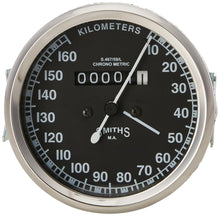Royal Enfield Smith Speedometer
Item Code-203
A motorcycle speedometer is an essential instrument that measures and displays the speed at which a motorcycle is traveling. They come in various types and styles, catering to different motorcycle models and rider preferences. Here’s an overview of the types, features, installation, and maintenance of motorcycle speedometers:
Types of Motorcycle Speedometers
-
Analog Speedometers:
- Mechanical Analog Speedometers: These use a cable connected to the front wheel or gearbox, which turns a magnet inside the speedometer, moving the needle to indicate speed.
- Electronic Analog Speedometers: These have a similar look to mechanical ones but use electronic sensors and wiring to measure and display speed.
-
Digital Speedometers:
- LCD/LED Displays: These speedometers use digital screens to display speed and other information like odometer readings, fuel level, and sometimes additional data like trip meters, clock, and gear position.
- GPS Speedometers: These use satellite signals to measure speed, which can be more accurate and are not affected by wheel or tire changes.
Key Features
- Readability: Easy-to-read displays, whether analog or digital, are crucial for quick glances while riding.
- Backlighting: Important for nighttime riding, ensuring the speedometer is visible in low-light conditions.
- Durability: Must withstand vibrations, weather conditions, and potential impacts.
- Accuracy: Accurate speed readings are essential for safety and legal compliance.
- Additional Functions: Some modern speedometers offer extra features like a tachometer (measuring engine RPM), fuel gauge, and even Bluetooth connectivity for pairing with smartphones.
Installation
- Gather Tools and Parts: Depending on the type of speedometer, you might need screwdrivers, wrenches, mounting brackets, and possibly wiring tools.
- Mounting the Speedometer: Securely mount the speedometer to the handlebars or dash using the provided brackets.
- Connecting Mechanical Speedometers: Attach the drive cable to the speedometer and the other end to the front wheel or gearbox.
- Connecting Electronic Speedometers: Install the sensor near the front or rear wheel and run the wiring to the speedometer. Ensure all connections are secure and waterproofed if necessary.
- Calibration: For mechanical speedometers, this might involve ensuring the cable is properly tensioned. For electronic models, follow the manufacturer’s instructions for calibration, which might involve setting the correct wheel circumference or other parameters.
Maintenance
- Regular Checks: Ensure all connections are tight and the speedometer is securely mounted.
- Lubrication: For mechanical speedometers, regularly lubricate the drive cable to prevent it from seizing.
- Cleaning: Keep the speedometer and its sensor clean to ensure accurate readings.
- Updating Software: For digital speedometers with software, periodically check for updates that might improve functionality or accuracy.
Popular Brands
- Smiths: Known for their classic designs, especially on vintage and British motorcycles.
- Trail Tech: Offers a range of digital speedometers with advanced features.
- Koso: Provides high-quality digital and analog speedometers with a variety of features.
- Acewell: Known for durable and feature-rich digital speedometers.
Conclusion
Choosing the right speedometer for your motorcycle depends on your needs and preferences, such as whether you prefer a classic look or modern digital functionality. Proper installation and maintenance are key to ensuring your speedometer provides accurate and reliable readings.






